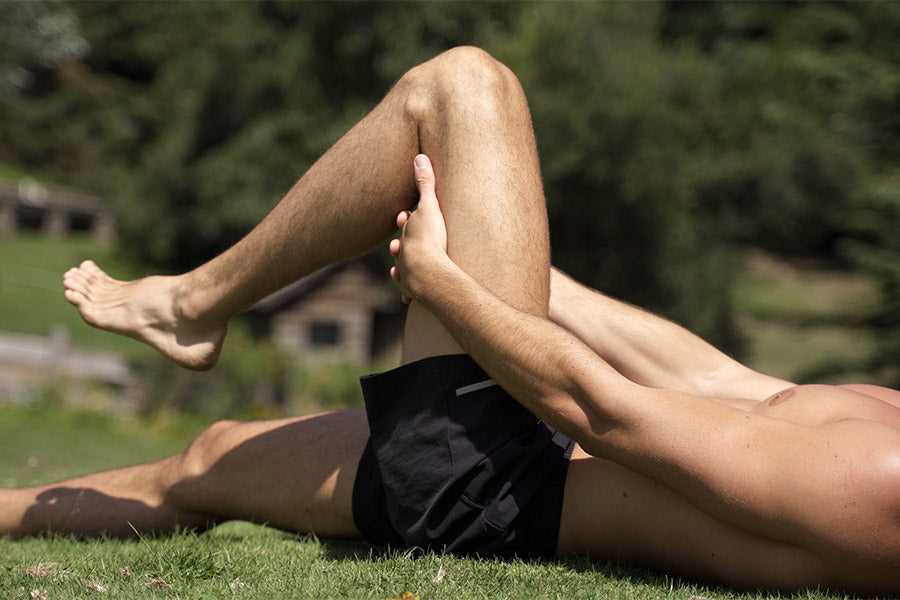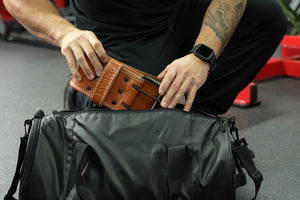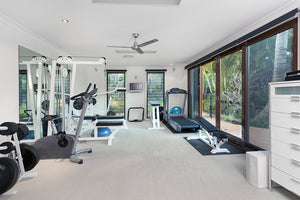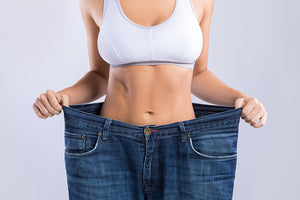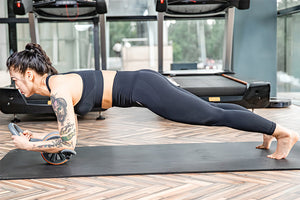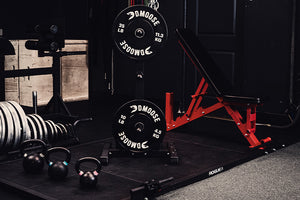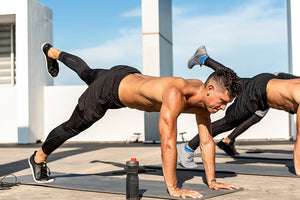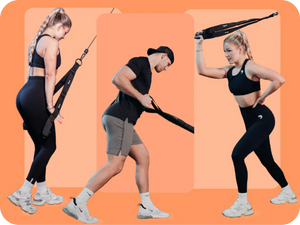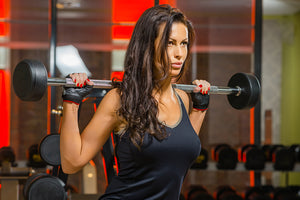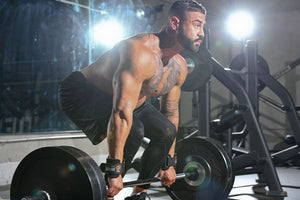Hamstrings are often overshadowed by their well-known cousins, the quads. But having strong hamstrings is essential for building muscle and boosting your athleticism. Hamstring exercises help improve your balance and stability, decrease your risk of injury, and increase your speed and power.
But with so many different options, it can be hard to know where to start. That's why we've compiled a list of the 10 best hamstring activation exercises to help you get started. These exercises will help you build muscle, strength, power, and endurance.
Whether a beginner or a professional athlete, they will help you take your performance to the next level. So, let’s start with the basic anatomy of your hamstrings and the science behind effective hamstring muscle training!
The Anatomy of the Hamstring Muscles

The hamstrings have three muscles: the semitendinosus, the semimembranosus, and the biceps femoris. Hamstrings attach to the pelvis at the ischial tuberosity and extend down the back of the leg to insert at the knee. The hamstrings are responsible for knee flexion and hip extension.
Hamstring exercises at the gym target all three muscles in the group. Hamstring stretches should be part of every fitness routine, whether you're a novice exerciser or a professional athlete. Here's a closer look at the anatomy of these essential muscles.
The semitendinosus is the long, thin muscle that runs down the middle of the back of your leg. It's responsible for knee flexion and hip extension. The semimembranosus is located just underneath the semitendinosus. It also assists with knee flexion and hip extension.
The biceps femoris is located on the outer side of your leg and attaches to both the pelvis and the femur (thigh bone). It helps laterally rotate (turn out) your thigh at your hip joint.
All three muscles work together to help you move your leg backward (as in a backward lunge), bend your knee (as in a sit-up), and rise from a sitting position.
The Simple Science of Effective Hamstring Training
When it comes to hamstring training, there are different opinions and different theories. Some claim you need to concentrate on high-rep training and feel the heat. Others say that using heavier weights is essential.
Some folks advise you to perform hamstring-specific exercises. Others argue that you should remain with the large compound movements and avoid isolation.
And some still advocate dividing your leg exercises into hamstring and quadriceps exercises, while the rest claim that this won't help you and may even be harmful.
So what’s the right approach for hamstring training? Well, a certified personal trainer Bigger Leaner Stronger, Thinner Leaner Stronger, and Muscle for Life author Michael Matthews has the following insights:
1. Hamstring-Focusing Exercises are the Best.
Exercises that emphasize the hamstrings, like sumo squats, kettlebell swings, single-leg deadlifts, etc., balance the growth of your entire leg.
2. Heavy Compound Motions are the Finest Exercises For Gaining Strength And Size.
You can incorporate high-rep sets and machine exercises in hamstring routines but cannot replace strenuous free-weight activities.
3. One Advanced Hamstring Workout Per Week Is Adequate.
One of the important components of your hamstring workout is volume, the total number of reps you perform each week. This is particularly crucial if you engage in a lot of intense weightlifting because the general principle is:
‘The heavier you lift, the fewer reps you can perform each week without running the risk of overtraining.’
It is true for compound exercises like the deadlift and squat because they require more recovery time than less demanding (but still effective) exercises like biceps curls or chest flies.
According to a review study, when your training focuses on heavy weights (80 to 85%+ of 1RM), the ideal volume appears to be 60-70 reps performed every 5 to 7 days.
It holds for all major muscle groups, not just the hamstrings.
In the case of the hamstrings, many of the quadriceps workouts you'll perform also engage them. For instance, the quadriceps are primarily responsible for the first part of the squat, but as you descend, the hamstrings are heavily utilized.
(This is one of the many reasons you should squat so that your thighs become parallel to the ground or slightly below it.)
Here’s the adjustment: You need to reduce the volume of your hamstring (and quadriceps) workouts to account for this overlap.
Okay, now that we've covered some fundamental training principles, it's time to look at the top hamstring workouts for strength and muscle growth.
Related Article: Five At-Home Exercises for Athletes to Build Stronger Legs
The Best Hamstring Exercises
There are a variety of exercises that target the hamstrings, but some are better than others. Here are 10 of the best hamstring exercises that you can do to build strength and definition:
1. Lying Leg Curl

Lying leg curls is an excellent way to build power and flexibility in the hamstrings. Performing this exercise with care will allow you to increase not only strength but also more mobility all around your lower body!
It increases mobility, lessens the chance of a knee injury, and encourages muscle development. This exercise can be done alone on the machine or by adding dumbbells to make it more difficult.
- Legs should be tucked under the padded pads when you belly-flop onto the machine.
- Make sure your ankles are securely fastened to the roller.
- Bring your legs up to your hips now. Throughout the move, tighten your hips and hamstrings.
- Return it to the initial position gradually.
- Repeat as many times as necessary.
2. Barbell Back Squat

No leg training is complete without the barbell back squat. It is the best exercise you can do to develop strong, powerful legs. Actually, it goes further than that because it works most of the major muscle groups across the entire body.
Squatting is undoubtedly a quadriceps exercise, and you may think it shouldn’t be included in your hamstring workouts. Well, this is one part of the story.
The other part is the deeper you go, the more it targets the hamstrings. So, you can include them as a hamstring exercise.
- Place a bar on your back.
- Make sure your feet are symmetrical and about hip width apart.
- Hinge at your hips and bend your knees simultaneously.
- Squat down to your desired depth that fits your current mobility.
- Drive through your midfoot to stand back up tall.
3. Bulgarian Split Squat
This workout is excellent for developing powerful quads and hamstrings. It aids in redressing any muscle imbalances that could result from repeated bilateral leg movements.
The exercise is incredibly effective in testing your balance, strengthening your core, and improving your control. It strengthens your flexibility and tones your glutes and legs. You can perform this as a bodyweight exercise or grab a pair of dumbbells.
- Position yourself in a split stance. You would have to stand with one leg straight and the other foot on a bench behind you.
- Hold a dumbbell with a neutral grip at your side.
- When your rear knee touches the ground, flex your front knee to the same extent.
- Drive through the full front foot to return to the starting position.
- Repeat as many times as necessary.
4. Standing Leg Curl

You may incorporate many single-leg exercises into your hamstring exercises for mass-building to address any potential asymmetries, including standing leg curl that builds hamstring bulk and strength.
The standing leg curl is performed one leg at a time as opposed to the lying leg curl, which promotes muscular attention and isolation. Additionally, it lessens muscle imbalances, boosts muscular hypertrophy, and improves the endurance of your hamstrings and glutes.
- Stand facing the machine, a bit on one side of it. Hook one of your heels under its roller pad, and support your weight with the other leg.
- Bend your knee and raise your heel toward your buttock to curl the weight.
- Hold for a few counts, then gradually return the weight to the starting position.
- After completing the set, switch legs and do it again.
5. Hip Bridge

The hip bridge is a good exercise for the butt, hamstring, and low back. Your glute muscles may become weaker, and your hip flexors in the front of your thighs may shorten because of spending most of the day sitting.
However, by routinely performing glute bridges, you are strengthening the muscles in your lower back, hamstrings, and glutes responsible for keeping your body upright. With these workouts, you may increase the size and strength of your hamstrings, back, and buttocks.
- Lie face up on the floor with your knees bent and your feet flat on the floor. Continually keep your arms by your sides, palms facing down.
- Lift your hips off the ground till your knees, hips, and shoulders are in a straight line.
- Squeeze your glutes firmly and maintain a tight abdominal core to avoid overextending your back throughout the workout.
- Keep your body in the spanned posture before gently backing down for a few seconds.
6. Nordic Hamstring Curl

The Nordic hamstring curl is a fantastic exercise for those looking to strengthen their hamstrings and avoid injuries. This exercise can be done with or without a resistance band, although employing a band has several added advantages.
- Wrap the band around the lat pulldown machine's upper portion.
- Put your knees on the knee pad and use both hands to hold the band behind your head.
- Reduce your height gradually until your body is parallel to the ground.
- Flex your hamstrings to help you return to the beginning position.
- Repeat as many times as necessary.
7. Kettlebell Swing

The hamstrings are the primary target of the kettlebell swing, a full-body exercise that works other muscles in the posterior chain.
It would be a great exercise for those still learning to stand in the hip hinge posture. They will benefit significantly from performing other workouts that need the hinge, particularly deadlifts.
It helps you develop functional strength, strengthens your weak muscles, and straightens up. Kettlebell swings can be a beneficial addition to any fitness regimen, regardless of what you are doing for exercise.
- Adopt a hinged position with your knees slightly bent and grasp the kettlebell handle with both hands.
- Keep your chin tucked and your weight evenly spread around your foot.
- Hike the kettlebell between your legs with a neutral spine.
- Then, stretch your hips while maintaining a straight posture as you pull the kettlebell back to the beginning position.
- Repeat as many times as necessary.
Related Article: 10 Kettlebell Exercises That Will Tone Your Entire Body
8. Glute-Hamstring Raise

Although this exercise appears simple, it is a hamstring killer when performed correctly. According to a study, it's one of the killer workouts you can do to activate your hamstring muscles.
- Adjust the footplate on the GHD and keep your knees resting at the bottom of the pad after. Your torso should be erect, your feet should be firmly planted on the footplate, and the bottom of your quadriceps should rest on the pad.
- Make sure your body is erect, your back is flat, and your legs are slightly wider than hip-width. Your arms should cover your chest.
- Extend your knees as you press your toes into the plate. Your body will advance as a result; continue until you are parallel to the floor. Maintain a flat back and extend your knees until they are completely straight.
- You can raise yourself back up by bending your knees and bringing your upper body back to the starting position. As they flex the knee and stretch the hip, the upper and lower hamstrings should be active.
- Repeat.
9. Barbell Good Morning

This exercise is a hip-hinge version that primarily works your glutes and hamstrings. Some individuals do this exercise to strengthen their backs, but to get the most out of it, you should execute it with your glutes as your primary emphasis.
The activity increases functional strength, lowers the chance of hamstring damage, enhances hip mobility, and results in bigger benefits. It can be one of the most beneficial workouts for the posterior chain if done correctly.
- Set the safeties to hip height and the bar on the rack at shoulder height.
- Place the bar just below or on your traps.
- Your hips should be back, and your spine should be neutral.
- To return to the starting posture, stretch the hip backward. Ensure that you drive all the way through the foot.
- Repeat as many times as necessary.
10. Romanian Deadlift

The Romanian deadlift is a powerful workout, just like its name suggests. It is a variant of the standard deadlift that focuses mostly on the glutes and hamstrings.
Thanks to the training, all the muscles involved in this movement will move more freely. Strength and coordination are increased, injury risk is reduced, and movement patterns are improved. Regardless of the training objective, this exercise is quite effective.
- Grasp a heavy barbell at your hips, making an overhand grip, and stand with your feet shoulder-width apart.
- Your knees ought to be somewhat bent.
- Ensure that your weight is floating close to the front of your leg as you slowly push your hips back.
- Lower until your torso is parallel to the ground or you start feeling a little stress in your hamstrings, whichever happens first.
- Pull your hips forward and stand to return to where you started. That’s 1 rep.
- Repeat as necessary.
TRENDING ARTICLES
FAQs
1. What everyday activities use hamstrings?
The everyday activities that use the hamstrings include running, climbing stairs, and kicking a ball. These movements require the muscles in the back of the thigh to contract and lengthen repeatedly, which stresses the hamstring tissue.
To protect against injury or strain, it is important to warm up and stretch before engaging in these activities. Additionally, properly conditioning your hamstrings through exercise can help them become stronger and tolerate the demands of these movements better.
2. Why are strong hamstrings important?
Strong hamstrings are important because they help maintain a proper posture, support the joints and ligaments of the legs, and enable the body to perform a wide range of movements and activities.
In addition to their functional benefits, strong hamstrings can also help improve your overall health and well-being by reducing strain on the muscles, tendons, and ligaments in the legs.
3. How important are hamstrings for speed?
While there is no definitive answer, it is generally accepted that having strong and flexible hamstrings is important for increasing speed, as they are one of the primary muscle groups responsible for generating power in the lower body. Some key factors to consider when training your hamstrings for speed include:
- Include a variety of exercises in your routine.
- Focus on both strength and flexibility.
- Maintain good form throughout each movement.
Additionally, it is important to engage in regular stretching and mobility work to keep your hamstrings loose and flexible. With consistent practice and attention to these factors, you can develop powerful, fast hamstrings that will help you reach your full potential as a runner or athlete.
4. What sport is good for the hamstrings?
Some activities often associated with strong, healthy hamstrings include running, cycling, and rowing.
The Bottom Line
If you're looking to build muscle and boost your athleticism, you need to focus on your hamstrings. These large muscles run down the back of your legs and are essential for everything from running and jumping to simply walking upstairs.
There are a variety of exercises that can target your hamstrings, but these 10 are some of the most essential. From Romanian deadlifts and back squats to more unconventional movements like Nordic hamstring curls, these exercises can help you build strength, power, and endurance. So if you're serious about taking your performance to the next level, add these hamstring exercises to your routine.
Reading List
Article Sources
- Peterson, Mark D., et al. “Applications of the Dose-Response for Muscular Strength Development: A Review of Meta-Analytic Efficacy and Reliability for Designing Training Prescription.” Journal of Strength and Conditioning Research, vol. 19, no. 4, Nov. 2005, pp. 950–58. PubMed, https://doi.org/10.1519/R-16874.1.
- WRIGHT, GLENN A., et al. “Electromyographic Activity of the Hamstrings During Performance of the Leg Curl, Stiff-Leg Deadlift, and Back Squat Movements.” The Journal of Strength and Conditioning Research, vol. 13, no. 2, 1999, p. 168. Dimensions, https://doi.org/10.1519/00124278-199905000-00012.


